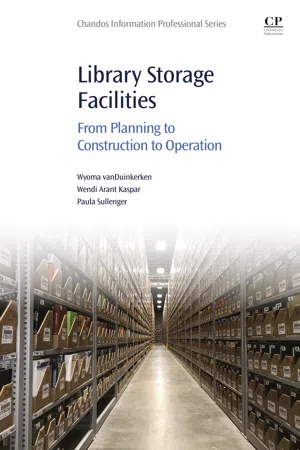
Library Storage Facilities
From Planning to Construction to Operation
- 266 pages
- English
- ePUB (mobile friendly)
- Available on iOS & Android
Library Storage Facilities
From Planning to Construction to Operation
About this book
Library Storage Facilities: From Planning to Construction to Operation examines high-density library storage facilities, considering how such facilities are changing the nature of collection management. The book discusses the types of storage facilities and explores how institutions can collaborate and embrace cost saving options through opening shared off-site storage facilities, addressing common needs, and maximizing value and space in on-campus libraries. Considering a unique partnership between the Texas A&M University System and the University of Texas System, the book highlights best practice and lessons learned during implementation. Topics covered include storage strategies, geometric efficiency, systems integration, environmental control, and more.- Provides insights on the importance of high-density library storage facilities- Lays out the process for funding, planning and building collaborations around storage facilities- Shows how to prepare a storage facility for operation in terms of staffing, workflow and equipment- Considers repurposing existing structures as a way of building a storage facility- Presents how to incorporate a storage facility into services and operations
Frequently asked questions
- Essential is ideal for learners and professionals who enjoy exploring a wide range of subjects. Access the Essential Library with 800,000+ trusted titles and best-sellers across business, personal growth, and the humanities. Includes unlimited reading time and Standard Read Aloud voice.
- Complete: Perfect for advanced learners and researchers needing full, unrestricted access. Unlock 1.4M+ books across hundreds of subjects, including academic and specialized titles. The Complete Plan also includes advanced features like Premium Read Aloud and Research Assistant.
Please note we cannot support devices running on iOS 13 and Android 7 or earlier. Learn more about using the app.
Information
Introduction
An Introduction to Storage Facilities
Types and Examples
Abstract
Keywords
1.1. Types of Storage Facilities
- 1. Institutional storage occurs when one library builds a storage unit, on or off an academic campus, to house its own material.
- 2. Cooperative (sometimes called shared) storage occurs when two or more libraries build a storage unit together to save money. However, there is no attempt by the two libraries to collaborate on what is placed in the storage unit, they just share the space. Within the cooperative model there are varying degrees of cooperation: collaborative, regional library center, and repository libraries:
- a. Collaborative storage occurs when two or more libraries (not necessarily from the same university) build a storage unit together and agree on collection management policies, such as format and duplicates, for the material they will be placing in storage.
- b. Regional library storage centers are storage units that have ongoing specialized collection development responsibility.
- c. Repository library storage units occur when a group of libraries come together to place items in a storage unit but they transfer the ownership of the item to the repository storage unit.2
1.1.1. Institutional Storage Facilities
1.1.2. Cooperative Shared Storage Facilities
1.1.2.1. Collaborative Facility
- • the scope of the subject materials that the facility will receive,
- • in what circumstances duplicate titles are accepted,
- • the condition of materials,
- • the format or medium of materials, and
- • circulation and access.
Table of contents
- Cover image
- Title page
- Table of Contents
- Chandos Information Professional Series
- Copyright
- Introduction
- Section 1. Consideration and Planning
- Section 2. Building the Storage Facility
- Section 3. Preparing for Operations
- Section 4. Transferring and Receiving Materials
- Section 5. Sustain Operations
- Section 6. Case Studies
- Index